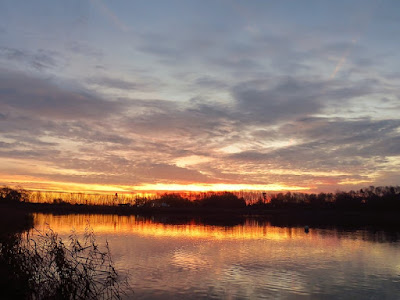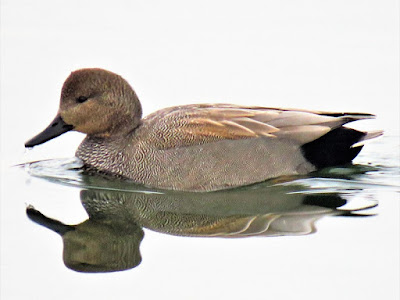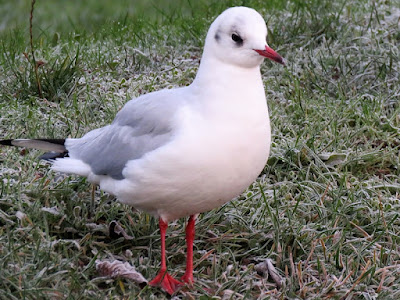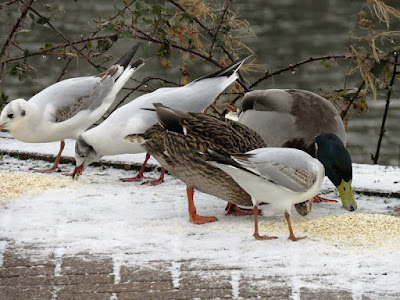0.0°C: Broken medium level cloud tended to increase after a colourful sunrise. Almost calm. Very good visibility.
Sunrise: 07:55 GMT
* = a photo today
Priorslee Lake: 06:35 – 09:10
(274th visit of the year)
Highlight was the small party of eight Golden Plover that flew over – rather high but the best view of the year by far.
A large conifer tree is laying across the N side path. I assume felled by Storm Arwen.
Bird notes:
- The cob Mute Swan and all three cygnets flew around and then left to the E at 08:20. They had not returned by 09:00. The pen was left on her own.
- Back to three pairs of Gadwall with the 'spare' drake, all together.
- Yet another Woodcock sighting with one flying to roost at 07:10.
- At least 200 Black-headed Gulls assembled on the water by 07:15 and stayed there until 07:30 unusually making almost no noise. After they dispersed very few gulls of any description noted.
- After my comment last Wednesday about the apparent absence of a Magpie roost this winter a number flushed this morning as I made my way along the N side. From underneath I could not determine how many. I would say at least 25.
- Just a lone Starling seen leaving the N side reeds. I was not positioned to necessarily see any leaving the W end.
- Very few Pied Wagtails heard flying over this morning. Perhaps the roost, wherever it was, has dispersed with the arrival of the cold weather.
- Two Reed Buntings seen leaving the N side and flying off SW. I often hear birds calling here at first light but rarely see them disperse. It is worth noting that the SOS (Shropshire Ornithological Society) undertake annual ringing at the Shifnal Sewage Farm and have recorded winter roosts there of over 300 Reed Buntings.
Overhead:
- 1 Feral Pigeon
- 2 Stock Doves: together
- 9 Wood Pigeons only
- *8 Golden Plover: as highlighted
- 2 Herring Gulls
- 22 Lesser Black-backed Gulls
- 1 Cormorant
- 123 Jackdaws
- 5 Rooks
- 1 Redwing
- 6 Pied Wagtails only heard
- 4 Siskins
Birds noted leaving roosts around the lake:
- 1 Starling
- 2 Reed Buntings
Warblers noted:
- 1 Cetti's Warbler: calls only
Counts from the lake area:
- *2 + 3 Mute Swans: the cob and three cygnets departed
- *7 (4♂) Gadwall
- 9 (6♂) Mallard
- 1 (1♂) Pochard
- 60 (30♂) Tufted Duck
- 3 Moorhens
- 52 Coots
- *2 Little Grebes
- *>200 Black-headed Gulls: see notes
- 3 Herring Gulls
- 8 Lesser Black-backed Gulls
- *1 Cormorant: arrived
At / around the street lamps pre-dawn:
Moths:
- *1 Winter Moth (Operophtera brumata)
Nothing else – wimps!
Later:
Nothing of note
A series of photos of the excellent sunrise this morning. This was taken very early, hand-held with a slow shutter speed: note the car-lights along Castle Farm Way as streaks.
Colouring up.
Even better.
And now red almost half way across the sky.
The three cygnets make a suitable foreground.
A big fir tree, felled by Storm Arwen no doubt, blocking the N side path.
How could I resist this drake Gadwall?
Or this one?
Two Little Grebes popped out of the reeds while it was still very dark: looked about: and disappeared again. A record shot of one of them.
This Cormorant is in the process of swallowing whatever it has caught. I find the eyes of this group of birds fascinating whether they are blue, as here; green as in the more maritime Shag; or red as in some related species in the Southern Hemisphere.
And if you think Cormorant feathers are all-black then think again. If the light is at the right angle they gloss green and mauve as here.
Another that won't win prizes. These eight Golden Plover were high and fast-flying. By the time I got the camera on them they were also some way passed. Just about noticeable are the long pointed wings that characterise this species in flight.
Robins do look unusual when seen from head-on!
This Pied Wagtail has also worked out where to get titbits. These fast-running birds are happy mixing it with the vehicles in the lay-by as they search for morsels.
The only thing brave-enough to sit on any of the frost-covered lamp posts was this Winter Moth (Operophtera brumata)
(Ed Wilson)
The Flash: 09:15 – 10:15
(250th visit of the year)
c.40% mainly thin ice
Bird notes:
- Back to two drake Pochard.
Birds noted flying over here:
- 1 Common Buzzard
- 1 Starling
- 5 Fieldfares: together
- 1 Siskin
On /around the water:
- 9 Canada Geese: two of these flew in
- 3 + 2 (1 brood) Mute Swans
- 36 (23♂) Mallard
- *2 (2♂) Pochard
- *72 (30♂) Tufted Duck
- 6 (3♂) Goosander
- 11 Moorhens
- 26 Coots
- 2 Great Crested Grebes: again
- 31 Black-headed Gulls
- *1 Lesser Black-backed Gull: adult
- 1 Grey Heron: again
Of note:
(Ed Wilson)
------------------------------------------------------------------------------------------------------
The Flash: 09:15 – 10:15
(250th visit of the year)
c.40% mainly thin ice
Bird notes:
- Back to two drake Pochard.
Birds noted flying over here:
- 1 Common Buzzard
- 1 Starling
- 5 Fieldfares: together
- 1 Siskin
On /around the water:
- 9 Canada Geese: two of these flew in
- 3 + 2 (1 brood) Mute Swans
- 36 (23♂) Mallard
- *2 (2♂) Pochard
- *72 (30♂) Tufted Duck
- 6 (3♂) Goosander
- 11 Moorhens
- 26 Coots
- 2 Great Crested Grebes: again
- 31 Black-headed Gulls
- *1 Lesser Black-backed Gull: adult
- 1 Grey Heron: again
Of note:
Nothing else
Feeding time! Some kind person has put down some seed. A pair of Mallard and three Black-headed Gulls are tucking in. Two of the gulls are first-winter birds with brown markings on the folded wings.
If there is food in the offing then a Wood Pigeon will not be far away.
Two drake Pochard today. Both together – they were definitely not doing synchronised diving so it was a challenge to get them both on the surface. The very fine vermiculations on the grey plumage are just about visible.
Talking of handsome ducks... a splendid drake Tufted Duck. Not much of a 'tuft' as yet.
A bigger 'tuft' but some retained eclipse plumage feathers in the flanks still to be replaced. Note the wide tail resting on the surface, used as a rudder when it is diving.
This drake still has even more flank feathers to moult and a tuft to grow before coming in to breeding condition.
Mr. Grumpy (or perhaps Mrs. Grumpy – I cannot sex this species). This is a full adult Lesser Black-backed Gull with only the merest dark mark on the upper mandible. The legs are supposed to be yellow – brighter when in breeding condition next Spring. I suppose they are not as pink as its feet. This bird is unusual for this date in showing almost no dark markings on the head.
Not much light to catch these energetic Long-tailed Tits as they frantically search for food in the limited hours of daylight.
Off it goes.
A Nuthatch with a nut. Will it hatch? As noted previously the bird's name is derived from 'nut hack' as they attack nuts to get at the kernels. It seems to have done that here.
The angle rather foreshortens the body but the tailless appearance is very obvious in flight
(Ed Wilson)
------------------------------------------------------------------------------------------------------
On this day can be found via the yearly links in the right-hand column.
Sightings from previous years without links are below
2013
Priorslee Lake
6 Gadwall
2 Pochard
2 Teal
1 Shoveler
Shelduck
1 Yellow-legged Gull
4 Great Black-backed Gulls
(JW Reeves / John Isherwood)
2012
Priorslee Lake
Goldeneye
3 Gadwall
6 Pochard
33 Tufted Ducks
144 Coots
Woodcock
216 Black-headed Gulls
c.480 Lesser Black-backed Gulls
47 Herring Gulls
2 Great Black-backed Gulls
c.950 Wood Pigeons
16 Redwings
2 Fieldfares
c.560 Jackdaws
81 Rooks
11 Siskins
3 Redpolls
(Ed Wilson)
2011
Priorslee Lake
3 Yellow-legged Gulls
1 Great Black-backed Gull
(John Isherwood)
2010
Madeley
3 Waxwings
(Pete Nickless)
2009
Priorslee Lake
Drake Pintail
(Martin & Ian Grant)
2006
Priorslee Lake
1 Little Grebe
28 Pochard
54 Tufted Ducks
1 drake Ruddy Duck
>1450 Black-headed Gulls
331 Lesser Black-backed Gulls
278 Wood Pigeons
35 Robins
27 Blackbirds
69 Fieldfares
7 Song Thrushes
13 Redwings
1 Siskin
8 Reed Buntings
(Ed Wilson)
2005
Priorslee Lake
2 Little Grebes again
2 Wigeon
2 Pochard
47 Tufted Duck
223 Coot
A drake Shoveler
7+ Cormorants
8000 Black-headed Gulls
3500 Lesser Black-backed Gulls
7 Herring Gulls
25 Golden Plover
14 Fieldfares
8 Redwings
13 Sky Larks
7 Reed Buntings
(Ed Wilson)


























